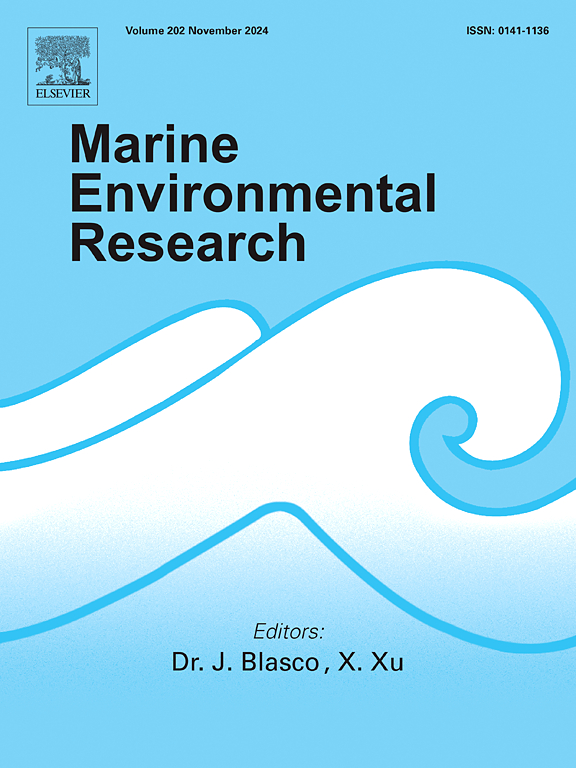Slow recovery in temperate mesophotic communities following disturbance: An example from Lough Hyne (Ireland)
IF 3.2
3区 环境科学与生态学
Q2 ENVIRONMENTAL SCIENCES
引用次数: 0
Abstract
Despite the ecological importance of temperate mesophotic ecosystems (TMEs), our understanding of the ecological processes within these systems and their potential to recover from disturbance remains limited. Here, we investigated the temporal dynamics of mesophotic sponge-dominated communities at Lough Hyne Marine Nature Reserve (Ireland) following a significant sponge mortality event in the early 2010s. Through the analysis of permanent quadrat data from 1994 to 1995 (pre-disturbance) and 2018–2021 (post-disturbance), we quantified the temporal variation in recovery rates of benthic communities and sponge populations across an environmental gradient. Although communities changed as a result of the disturbance, multivariate analyses did not detect any temporal changes in communities or sponge assemblages in the periods preceding or immediately after the disturbance. However, we did find a small increase in the abundance of some habitat-forming sponges and anemones at some sites, suggesting that a slow recovery may be underway. In contrast, other sites showed no signs of recovery. The heterogeneity of temporal dynamics and recovery trajectories among sites highlights the potential influence of environmental conditions on recovery. At current rates, some sponge populations may take decades to recover assuming there is no further disturbance. In general, we found that sponges and cnidarians showed very small temporal fluctuations both before and after the disturbance, suggesting high temporal constancy of these organisms in TMEs. These small temporal fluctuations likely derive from the slow growth, long lifespan, and low fecundity of many temperate mesophotic sponges and cnidarians. These results provide rare empirical evidence for long recovery times (several to many decades) of TME benthic communities following disturbance, as little recovery was observed at Lough Hyne after at least six years following the mortality events. As many TMEs worldwide remain largely unprotected, urgent global action is needed to conserve these ecosystems since any human impact may have long-lasting effects on TME biodiversity and ecosystem services.

干扰后温带中叶藻群落恢复缓慢:以爱尔兰海恩湖为例
尽管温带中叶藻生态系统(TMEs)具有重要的生态意义,但我们对这些系统内的生态过程及其从干扰中恢复的潜力的了解仍然有限。在这里,我们研究了2010年代初在爱尔兰海恩湖海洋自然保护区(Lough Hyne Marine Nature Reserve)发生的重大海绵死亡事件后,以中磷海绵为主的群落的时间动态。通过分析1994 - 1995年(干扰前)和2018-2021年(干扰后)的永久样方数据,我们量化了不同环境梯度下底栖生物群落和海绵种群恢复率的时间变化。尽管群落因干扰而发生变化,但多变量分析并未发现群落或海绵组合在干扰之前或之后的任何时间变化。然而,我们确实发现一些栖息地形成海绵和海葵的丰度有小幅增加,这表明可能正在缓慢恢复。相比之下,其他地区没有显示出复苏的迹象。地点间时间动态和恢复轨迹的异质性突出了环境条件对恢复的潜在影响。按照目前的速度,假设没有进一步的干扰,一些海绵种群可能需要几十年才能恢复。总的来说,我们发现海绵和刺胞动物在干扰前后的时间波动非常小,表明这些生物在TMEs中的时间稳定性很高。这些小的时间波动可能源于许多温带中孔海绵和刺胞动物的生长缓慢、寿命长和繁殖力低。这些结果为干扰后TME底栖生物群落恢复时间长(几十年到几十年)提供了罕见的经验证据,因为在死亡事件发生至少6年后,在Hyne湖几乎没有观察到恢复。由于世界各地的许多生态系统在很大程度上仍未受到保护,因此需要采取紧急全球行动来保护这些生态系统,因为任何人类影响都可能对生态系统的生物多样性和生态系统服务产生长期影响。
本文章由计算机程序翻译,如有差异,请以英文原文为准。
求助全文
约1分钟内获得全文
求助全文
来源期刊

Marine environmental research
环境科学-毒理学
CiteScore
5.90
自引率
3.00%
发文量
217
审稿时长
46 days
期刊介绍:
Marine Environmental Research publishes original research papers on chemical, physical, and biological interactions in the oceans and coastal waters. The journal serves as a forum for new information on biology, chemistry, and toxicology and syntheses that advance understanding of marine environmental processes.
Submission of multidisciplinary studies is encouraged. Studies that utilize experimental approaches to clarify the roles of anthropogenic and natural causes of changes in marine ecosystems are especially welcome, as are those studies that represent new developments of a theoretical or conceptual aspect of marine science. All papers published in this journal are reviewed by qualified peers prior to acceptance and publication. Examples of topics considered to be appropriate for the journal include, but are not limited to, the following:
– The extent, persistence, and consequences of change and the recovery from such change in natural marine systems
– The biochemical, physiological, and ecological consequences of contaminants to marine organisms and ecosystems
– The biogeochemistry of naturally occurring and anthropogenic substances
– Models that describe and predict the above processes
– Monitoring studies, to the extent that their results provide new information on functional processes
– Methodological papers describing improved quantitative techniques for the marine sciences.
 求助内容:
求助内容: 应助结果提醒方式:
应助结果提醒方式:


